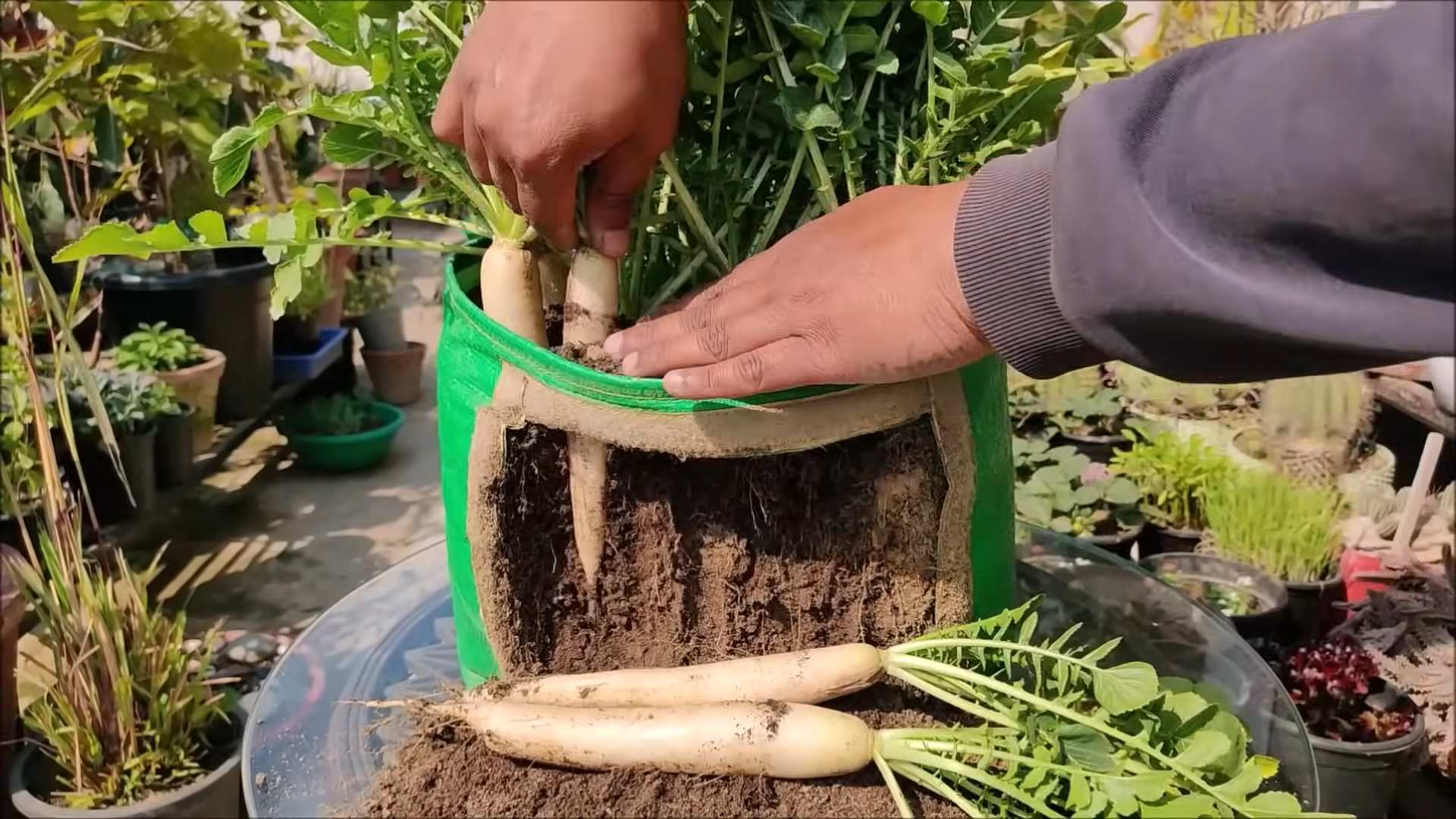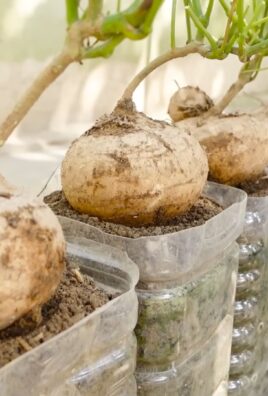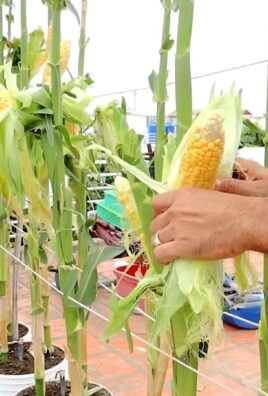Grow White Radish Quickly and enjoy the crisp, peppery flavor of homegrown radishes in just a few weeks! Imagine plucking fresh, vibrant white radishes straight from your garden, adding a delightful crunch to your salads, or enjoying them as a refreshing snack. But what if I told you that you could speed up the process and harvest your radishes even faster?
Radishes have a rich history, dating back to ancient times. They were cultivated in Egypt before the pyramids were built and were highly valued by the Greeks and Romans for their medicinal properties and culinary uses. Today, radishes remain a popular vegetable worldwide, known for their ease of cultivation and quick growth.
Many gardeners struggle with slow-growing radishes, often waiting weeks only to find small, underdeveloped roots. This DIY guide is designed to help you overcome these challenges and grow white radish quickly and efficiently. I’ll share my favorite tips and tricks, from soil preparation to watering techniques, ensuring you get a bountiful harvest in record time. Whether you’re a seasoned gardener or just starting, these simple hacks will transform your radish-growing experience. Get ready to enjoy the satisfaction of harvesting your own delicious, homegrown radishes sooner than you ever thought possible!

Grow White Radishes in Just 3 Weeks: A DIY Guide
Hey there, fellow gardening enthusiasts! Are you craving the crisp, peppery bite of fresh radishes but don’t want to wait an eternity to harvest them? Well, you’re in luck! I’m going to share my super-speedy method for growing white radishes in as little as three weeks. Yes, you read that right – three weeks! This isn’t some gardening myth; it’s a tried-and-true technique that I’ve perfected over the years. So, grab your gardening gloves, and let’s get started!
What You’ll Need
Before we dive into the planting process, let’s gather all the necessary materials. Having everything on hand will make the whole experience smoother and more enjoyable.
* White Radish Seeds: Choose a variety known for its quick maturity. ‘French Breakfast’ or ‘Cherry Belle’ are excellent choices, but any white radish variety will work.
* Well-Draining Soil: Radishes thrive in loose, fertile soil. A mix of compost, potting soil, and a little bit of sand works wonders.
* Container or Garden Bed: You can grow radishes in containers or directly in your garden bed. If using a container, make sure it’s at least 6 inches deep.
* Watering Can or Hose: Consistent moisture is key for rapid radish growth.
* Fertilizer (Optional): A balanced, water-soluble fertilizer can give your radishes an extra boost.
* Gardening Gloves: To keep your hands clean and protected.
* Trowel or Small Shovel: For planting the seeds.
* Row Cover or Netting (Optional): To protect your radishes from pests.
Preparing the Soil
The foundation of any successful garden is healthy soil. Radishes need loose, well-draining soil to develop properly. Compacted soil can lead to stunted growth and misshapen radishes.
1. Choose Your Location: Radishes need at least 6 hours of sunlight per day. Select a sunny spot in your garden or on your patio.
2. Prepare the Soil: If you’re using a garden bed, loosen the soil with a garden fork or tiller to a depth of at least 6 inches. Remove any rocks, weeds, or debris.
3. Amend the Soil: Mix in plenty of compost to improve drainage and fertility. I usually add about 2-3 inches of compost to the topsoil and work it in thoroughly. If your soil is heavy clay, add some sand to improve drainage.
4. Level the Surface: Rake the soil to create a smooth, even surface. This will make planting easier and ensure that the radishes receive even watering.
5. For Containers: Fill your container with a high-quality potting mix. Make sure the container has drainage holes to prevent waterlogging. I like to add a layer of gravel at the bottom of the container to further improve drainage.
Planting the Radish Seeds
Now comes the fun part – planting the seeds! Radishes are relatively easy to grow from seed, and they germinate quickly.
1. Create Furrows: Use your finger or a trowel to create shallow furrows in the soil, about ½ inch deep and 1 inch apart.
2. Sow the Seeds: Sprinkle the radish seeds evenly along the furrows, spacing them about ½ inch apart. Don’t overcrowd the seeds, as this can lead to smaller radishes.
3. Cover the Seeds: Gently cover the seeds with a thin layer of soil.
4. Water Thoroughly: Use a watering can or hose to gently water the soil. Be careful not to wash away the seeds. The soil should be moist but not waterlogged.
5. Label Your Rows: It’s always a good idea to label your rows with the date and variety of radish you planted. This will help you keep track of your progress.
Caring for Your Radishes
Consistent care is essential for growing radishes quickly. Here’s what you need to do to keep your radishes happy and healthy.
1. Water Regularly: Radishes need consistent moisture to grow quickly and develop a crisp texture. Water deeply whenever the top inch of soil feels dry to the touch. Avoid overwatering, as this can lead to root rot.
2. Thin Seedlings: Once the seedlings emerge (usually within 3-7 days), thin them to about 1 inch apart. This will give the radishes enough space to grow. Simply snip off the extra seedlings at the soil line with scissors.
3. Fertilize (Optional): If you want to give your radishes an extra boost, you can fertilize them with a balanced, water-soluble fertilizer. Follow the instructions on the fertilizer package. I usually fertilize my radishes about once a week.
4. Weed Regularly: Keep the area around your radishes free of weeds. Weeds can compete with the radishes for nutrients and water. Gently pull weeds by hand, being careful not to disturb the radish roots.
5. Protect from Pests: Radishes can be susceptible to pests such as flea beetles and root maggots. To protect your radishes, you can cover them with a row cover or netting. You can also use organic pest control methods, such as diatomaceous earth or neem oil.
Harvesting Your Radishes
The best part of growing radishes is harvesting them! Radishes are ready to harvest when they are about 1 inch in diameter, usually within 3-4 weeks of planting.
1. Check for Maturity: Gently brush away the soil around the base of the radish to check its size. If it’s about 1 inch in diameter, it’s ready to harvest.
2. Harvest Carefully: Grasp the radish leaves near the base and gently pull the radish out of the soil. If the soil is dry, you may need to loosen it with a trowel first.
3. Wash and Store: Wash the radishes thoroughly to remove any dirt. Trim off the leaves and roots. Store the radishes in a plastic bag in the refrigerator. They will keep for about a week.
Troubleshooting
Even with the best care, sometimes things can go wrong. Here are some common problems you might encounter when growing radishes and how to fix them.
* Radishes are too small: This could be due to overcrowding, lack of water, or poor soil. Thin the seedlings, water regularly, and amend the soil with compost.
* Radishes are cracked: This is usually caused by inconsistent watering. Water regularly and deeply, especially during dry spells.
* Radishes are pithy or woody: This can happen if the radishes are left in the ground too long. Harvest them as soon as they are ready.
* Radishes are bitter: This can be caused by hot weather or lack of water. Provide shade during the hottest part of the day and water regularly.
* Pests are attacking my radishes: Use row covers or netting to protect your radishes from pests. You can also use organic pest control methods, such as diatomaceous earth or neem oil.
Tips for Success
Here are a few extra tips to help you grow the best radishes ever!
* Succession Planting: Plant a new batch of radish seeds every 1-2 weeks for a continuous harvest.
* Choose the Right Variety: Some radish varieties are better suited for certain climates and growing conditions. Do some research to find the best variety for your area.
* Don’t Overcrowd: Give your radishes enough space to grow. Thin the seedlings to about 1 inch apart.
* Water Consistently: Radishes need consistent moisture to grow quickly and develop a crisp texture.
* Harvest Promptly: Harvest your radishes as soon as they are ready. Leaving them in the ground too long can cause them to become pithy or woody.
* Enjoy Your Harvest: Radishes are delicious raw in salads, sandwiches, or as a snack. You can also cook them in stir-fries or soups.
Radish Recipes to Try
Now that you’ve harvested your beautiful white radishes, it’s time to enjoy them! Here are a few of my favorite radish recipes:
* Radish and Butter Sandwiches: Thinly slice radishes and spread them on buttered bread. Sprinkle with sea salt and enjoy!
* Radish Salad: Combine sliced radishes, cucumbers, and tomatoes in a bowl. Dress with a vinaigrette dressing.
* Roasted Radishes: Toss radishes with olive oil, salt, and pepper. Roast in the oven at 400°F (200°C) for 20-25 minutes, or until tender.
* Radish Greens Pesto: Don’t throw away the radish greens! Use them to make pesto. Combine radish greens, garlic, Parmesan cheese, pine nuts, and

Conclusion
So, there you have it! Growing white radishes quickly at home is not only achievable but also incredibly rewarding. This simple DIY trick transforms the often-lengthy radish-growing process into a speedy and satisfying experience. Forget waiting weeks; with the right approach, you can be enjoying crisp, peppery radishes in a fraction of the time.
Why is this a must-try? Because it puts fresh, homegrown produce within easy reach, regardless of your gardening experience or space limitations. Imagine the satisfaction of harvesting your own radishes, knowing exactly where they came from and what went into growing them. Plus, the faster turnaround means you can enjoy multiple harvests throughout the growing season, maximizing your yield and minimizing the wait.
But the benefits don’t stop there. This method also allows for greater control over the growing environment, leading to healthier, more flavorful radishes. You can tailor the soil composition, watering schedule, and light exposure to create the ideal conditions for rapid growth. And let’s not forget the cost savings! Growing your own radishes eliminates the need to purchase them from the store, saving you money and reducing your reliance on commercially grown produce.
Looking for variations? Consider experimenting with different radish varieties. While the techniques outlined here are generally applicable to all white radishes, some varieties may respond even better to accelerated growth methods. Try ‘French Breakfast’ for a milder flavor or ‘Sparkler’ for a vibrant red and white radish. You can also explore different soil amendments to further enhance growth. Adding compost or well-rotted manure can provide essential nutrients and improve soil drainage.
Another exciting variation is to try growing radishes in containers. This is a great option for those with limited space or who want to grow radishes indoors. Choose a container that is at least 6 inches deep and filled with well-draining potting mix. Place the container in a sunny location and water regularly.
Don’t be afraid to get creative with your radish recipes! Radishes are incredibly versatile and can be used in a variety of dishes. Add them to salads for a peppery crunch, slice them thinly and serve them on toast with butter and sea salt, or pickle them for a tangy treat. You can even roast them for a sweeter, more mellow flavor.
We wholeheartedly encourage you to give this DIY trick a try. It’s a fun, educational, and ultimately delicious way to connect with nature and enjoy the fruits (or rather, roots) of your labor. Once you’ve experienced the joy of growing your own white radishes quickly, you’ll never look at store-bought radishes the same way again.
And most importantly, we want to hear about your experience! Share your tips, tricks, and successes in the comments below. Let us know what worked for you, what challenges you faced, and what delicious recipes you created with your homegrown radishes. Together, we can learn and grow (pun intended!) as a community of radish enthusiasts. So, grab your seeds, get your hands dirty, and get ready to enjoy the freshest, most flavorful radishes you’ve ever tasted! Happy gardening!
Frequently Asked Questions (FAQ)
What are the best conditions for growing white radishes quickly?
The key to rapid radish growth lies in providing the optimal conditions. This includes well-draining soil rich in organic matter, consistent moisture, and plenty of sunlight. Aim for at least 6 hours of direct sunlight per day. The ideal soil temperature for radish germination is between 60°F and 70°F (15°C and 21°C). Ensure the soil is loose and free of rocks or clumps to allow for easy root development. Avoid overwatering, as this can lead to root rot.
How often should I water my radishes?
Radishes need consistent moisture to grow quickly and develop crisp, flavorful roots. Water deeply whenever the top inch of soil feels dry to the touch. Avoid letting the soil dry out completely, as this can cause the radishes to become tough and bitter. During hot, dry weather, you may need to water more frequently. Using a soaker hose or drip irrigation can help to deliver water directly to the roots and prevent water loss through evaporation.
What kind of soil is best for growing radishes?
Radishes thrive in well-draining, loose soil that is rich in organic matter. A sandy loam soil is ideal. Avoid heavy clay soils, as they can become compacted and restrict root growth. Before planting, amend the soil with compost or well-rotted manure to improve drainage and fertility. A slightly acidic soil pH of 6.0 to 7.0 is optimal for radish growth.
How do I prevent radishes from becoming too spicy?
The spiciness of radishes is influenced by several factors, including temperature, moisture, and variety. Hot weather and dry soil can contribute to a more pungent flavor. To reduce spiciness, ensure consistent watering and provide some shade during the hottest part of the day. Choose milder radish varieties, such as ‘French Breakfast’ or ‘Cherry Belle’. Harvesting radishes when they are young and tender can also help to reduce their spiciness.
How long does it take for radishes to germinate?
Radish seeds typically germinate within 3 to 7 days, depending on soil temperature and moisture levels. To speed up germination, soak the seeds in water for 12 to 24 hours before planting. Keep the soil consistently moist during the germination period.
What are some common pests and diseases that affect radishes?
Radishes are generally resistant to pests and diseases, but they can be susceptible to certain problems, such as flea beetles, root maggots, and fungal diseases. Flea beetles can chew small holes in the leaves, while root maggots can damage the roots. To prevent flea beetles, cover the plants with row covers. To control root maggots, practice crop rotation and avoid planting radishes in the same location year after year. Fungal diseases can be prevented by ensuring good air circulation and avoiding overwatering.
Can I grow radishes indoors?
Yes, radishes can be grown indoors, especially if you want to grow white radishes quickly. Choose a container that is at least 6 inches deep and filled with well-draining potting mix. Place the container in a sunny location or under grow lights. Water regularly and fertilize with a balanced fertilizer.
How do I know when my radishes are ready to harvest?
Radishes are typically ready to harvest within 3 to 4 weeks of planting, depending on the variety and growing conditions. The roots should be about 1 inch in diameter. Gently loosen the soil around the radishes and pull them out of the ground. Harvest radishes when they are young and tender for the best flavor and texture.
Can I eat the radish greens?
Yes, radish greens are edible and nutritious. They have a peppery flavor similar to the roots. Wash the greens thoroughly before eating. They can be used in salads, soups, or stir-fries.
How do I store radishes after harvesting?
To store radishes, remove the greens and wash the roots. Place the radishes in a plastic bag or container and store them in the refrigerator. They will typically last for 1 to 2 weeks.





Leave a Comment